Insulin-Induced Recurrent Hypoglycemia Up-Regulates Glucose Metabolism in the Brain Cortex of Chemically Induced Diabetic Rats
Abstract
1. Introduction
2. Results
2.1. Characterization of Experimental Groups
2.2. Long-Term Hyperglycemia Down-Regulates GLUT3 Protein Levels in Brain Cortical Tissue
2.3. Recurrent Hypoglycemia Increases Mitochondrial Hexokinase Activity
2.4. Recurrent Hypoglycemia Increases Krebs Cycle Activity
2.5. Brain Cortical Mitochondria Biogenesis Is Altered by Long-Term Hyperglycemia and Recurrent Hypoglycemia
2.6. Mitochondrial Fission–Fusion Protein Content Is Differently Impacted under Long-Term Hyperglycemia and Recurrent Hypoglycemia
2.7. Recurrent Hypoglycemia Blunts Insulin Signaling-Mediated Pathways Leading to the Activation of GSK3β
3. Discussion
4. Materials and Methods
4.1. Chemicals and Reagents
4.2. Treatment of Animals
4.3. Determination of Blood Glucose and Glycated Hemoglobin Levels
4.4. Preparation of Mitochondrial Fraction
4.5. Brain Tissue Processing for Enzymatic Activity Determination
4.6. Measurement of Hexokinase Activity
4.7. Measurement of Glucose-6-Phosphate Dehydrogenase Activity
4.8. Measurement of Pyruvate Dehydrogenase (PDH) Activity
4.9. Measurement of Alpha-Ketoglutarate Dehydrogenase (A-KGDH) Activity
4.10. Measurement of Succinate Dehydrogenase Activity
4.11. Measurement of Citrate Synthase Activity
4.12. Determination of Adenine Nucleotide Levels
4.13. Western Blot Analysis
4.14. Statistical Analysis
Supplementary Materials
Author Contributions
Funding
Institutional Review Board Statement
Data Availability Statement
Conflicts of Interest
References
- American Diabetes Association. 2. Classification and Diagnosis of Diabetes:Standards of Medical Care in Diabetes—2018. Diabetes Care 2018, 41, S13–S27. [Google Scholar] [CrossRef] [PubMed]
- IDF Diabetes Atlas. Available online: https://www.diabetesatlas.org (accessed on 28 October 2021).
- De Beaufort, C.; Besançon, S.; Balde, N. Management of type 1 diabetes. Med. Sante Trop. 2018, 28, 359–362. [Google Scholar] [CrossRef]
- Chiang, J.L.; Kirkman, M.S.; Laffel, L.M.; Peters, A.L. Type 1 Diabetes Through the Life Span: A Position Statement of the American Diabetes Association. Diabetes Care 2014, 37, 2034–2054. [Google Scholar] [CrossRef] [PubMed]
- Grimm, A.; Eckert, A. Brain aging and neurodegeneration: From a mitochondrial point of view. J. Neurochem. 2017, 143, 418–431. [Google Scholar] [CrossRef] [PubMed]
- Languren, G.; Montiel, T.; Julio-Amilpas, A.; Massieu, L. Neuronal damage and cognitive impairment associated with hypoglycemia: An integrated view. Neurochem. Int. 2013, 63, 331–343. [Google Scholar] [CrossRef] [PubMed]
- Vilela, V.R.; Marques, A.D.C.R.; Schamber, C.R.; Bazotte, R.B. Hypoglycemia Induced by Insulin as a Triggering Factor of Cognitive Deficit in Diabetic Children. Sci. World J. 2014, 2014, 1–9. [Google Scholar] [CrossRef] [PubMed]
- Xia, W.; Luo, Y.; Chen, Y.-C.; Chen, H.; Ma, J.; Yin, X. Glucose Fluctuations Are Linked to Disrupted Brain Functional Architecture and Cognitive Impairment. J. Alzheimer’s Dis. 2020, 74, 603–613. [Google Scholar] [CrossRef] [PubMed]
- Zhang, J.; Chen, C.; Hua, S.; Liao, H.; Wang, M.; Xiong, Y.; Cao, F. An updated meta-analysis of cohort studies: Diabetes and risk of Alzheimer’s disease. Diabetes Res. Clin. Pract. 2016, 124, 41–47. [Google Scholar] [CrossRef] [PubMed]
- Koekkoek, P.S.; Kappelle, L.J.; Berg, E.V.D.; Rutten, G.E.H.M.; Biessels, G.J. Cognitive function in patients with diabetes mellitus: Guidance for daily care. Lancet Neurol. 2015, 14, 329–340. [Google Scholar] [CrossRef]
- Picard, M.; Wallace, D.C.; Burelle, Y. The rise of mitochondria in medicine. Mitochondrion 2016, 30, 105–116. [Google Scholar] [CrossRef]
- Santos, R.; Correia, S.; Alves, M.; Oliveira, P.; Cardoso, S.; Carvalho, C.; Duarte, A.; Santos, M.; Moreira, P. Insulin therapy modulates mitochondrial dynamics and biogenesis, autophagy and tau protein phosphorylation in the brain of type 1 diabetic rats. Biochim. Biophys. Acta—Mol. Basis Dis. 2014, 1842, 1154–1166. [Google Scholar] [CrossRef] [PubMed][Green Version]
- Cardoso, S.; Santos, R.X.; Correia, S.C.; Carvalho, C.; Santos, M.S.; Baldeiras, I.; Oliveira, C.R.; Moreira, P.I. Insulin-induced recurrent hypoglycemia exacerbates diabetic brain mitochondrial dysfunction and oxidative imbalance. Neurobiol. Dis. 2013, 49, 1–12. [Google Scholar] [CrossRef]
- Cardoso, S.; Santos, M.S.; Seiça, R.; Moreira, P.I. Cortical and hippocampal mitochondria bioenergetics and oxidative status during hyperglycemia and/or insulin-induced hypoglycemia. Biochim. Biophys. Acta (BBA) Mol. Basis Dis. 2010, 1802, 942–951. [Google Scholar] [CrossRef] [PubMed]
- Zhou, Y.; Huang, L.; Zheng, W.; An, J.; Zhan, Z.; Wang, L.; Chen, Z.; Liu, L. Recurrent nonsevere hypoglycemia exacerbates imbalance of mitochondrial homeostasis leading to synapse injury and cognitive deficit in diabetes. Am. J. Physiol. Endocrinol. Metab. 2018, 315, E973–E986. [Google Scholar] [CrossRef]
- Rehni, A.K.; Nautiyal, N.; Perez-Pinzon, M.A.; Dave, K.R. Hyperglycemia/hypoglycemia-induced mitochondrial dysfunction and cerebral ischemic damage in diabetics. Metab. Brain Dis. 2014, 30, 437–447. [Google Scholar] [CrossRef]
- Shokrzadeh, M.; Mirshafa, A.; Moghaddam, N.Y.; Birjandian, B.; Shaki, F. Mitochondrial dysfunction contribute to diabetic neurotoxicity induced by streptozocin in mice: Protective effect of Urtica dioica and pioglitazone. Toxicol. Mech. Methods 2018, 28, 499–506. [Google Scholar] [CrossRef] [PubMed]
- Nistor, M.; Schmidt, M.; Graul, I.; Rakers, F.; Schiffner, R. A Systematic Review of Neuroprotective Strategies in the Management of Hypoglycemia. Int. J. Mol. Sci. 2019, 20, 550. [Google Scholar] [CrossRef]
- Rehni, A.K.; Dave, K.R. Impact of Hypoglycemia on Brain Metabolism During Diabetes. Mol. Neurobiol. 2018, 55, 9075–9088. [Google Scholar] [CrossRef]
- Herzog, R.I.; Jiang, L.; Herman, P.; Zhao, C.; Sanganahalli, B.G.; Mason, G.F.; Hyder, F.; Rothman, D.L.; Sherwin, R.S.; Behar, K. Lactate preserves neuronal metabolism and function following antecedent recurrent hypoglycemia. J. Clin. Investig. 2013, 123, 1988–1998. [Google Scholar] [CrossRef] [PubMed]
- John, S.; Weiss, J.N.; Ribalet, B. Subcellular Localization of Hexokinases I and II Directs the Metabolic Fate of Glucose. PLoS ONE 2011, 6, e17674. [Google Scholar] [CrossRef] [PubMed]
- Cheng, H.; Gang, X.; Liu, Y.; Wang, G.; Zhao, X.; Wang, G. Mitochondrial dysfunction plays a key role in the development of neurodegenerative diseases in diabetes. Am. J. Physiol. Endocrinol. Metab. 2020, 318, E750–E764. [Google Scholar] [CrossRef] [PubMed]
- Schell, M.; Wardelmann, K.; Kleinridders, A. Untangling the effect of insulin action on brain mitochondria and metabolism. J. Neuroendocr. 2021, 33, e12932. [Google Scholar] [CrossRef] [PubMed]
- King, M.K.; Pardo, M.; Cheng, Y.; Downey, K.; Jope, R.S.; Beurel, E. Glycogen synthase kinase-3 inhibitors: Rescuers of cognitive impairments. Pharmacol. Ther. 2013, 141, 1–12. [Google Scholar] [CrossRef] [PubMed]
- King, M.R.; Anderson, N.; Guernsey, L.S.; Jolivalt, C.G. Glycogen synthase kinase-3 inhibition prevents learning deficits in diabetic mice. J. Neurosci. Res. 2013, 91, 506–514. [Google Scholar] [CrossRef]
- Jolivalt, C.; Lee, C.; Beiswenger, K.; Smith, J.; Orlov, M.; Torrance, M.; Masliah, E. Defective insulin signaling pathway and increased glycogen synthase kinase-3 activity in the brain of diabetic mice: Parallels with Alzheimer’s disease and correction by insulin. J. Neurosci. Res. 2008, 86, 3265–3274. [Google Scholar] [CrossRef] [PubMed]
- Kida, S. A Functional Role for CREB as a Positive Regulator of Memory Formation and LTP. Exp. Neurobiol. 2012, 21, 136–140. [Google Scholar] [CrossRef] [PubMed]
- Criego, A.B.; Tkac, I.; Kumar, A.; Thomas, W.; Gruetter, R.; Seaquist, E.R. Brain glucose concentrations in patients with type 1 diabetes and hypoglycemia unawareness. J. Neurosci. Res. 2004, 79, 42–47. [Google Scholar] [CrossRef] [PubMed]
- Kubiak, T.; Hermanns, N.; Schreckling, H.J.; Kulzer, B.; Haak, T. Assessment of hypoglycaemia awareness using continuous glucose monitoring. Diabet. Med. 2004, 21, 487–490. [Google Scholar] [CrossRef] [PubMed]
- Lei, H.; Gruetter, R. Effect of chronic hypoglycaemia on glucose concentration and glycogen content in rat brain: A localized13C NMR study. J. Neurochem. 2006, 99, 260–268. [Google Scholar] [CrossRef]
- Lee, D.H.; Chung, M.Y.; Lee, J.U.; Kang, D.G.; Paek, Y.W. Changes of glucose transporters in the cerebral adaptation to hypoglycemia. Diabetes Res. Clin. Pract. 2000, 47, 15–23. [Google Scholar] [CrossRef]
- Kumagai, A.K.; Kang, Y.-S.; Boado, R.J.; Pardridge, W.M. Upregulation of Blood-Brain Barrier GLUT1 Glucose Transporter Protein and mRNA in Experimental Chronic Hypoglycemia. Diabetes 1995, 44, 1399–1404. [Google Scholar] [CrossRef]
- Duelli, R.; Staudt, R.; Duembgen, L.; Kuschinsky, W. Increase in glucose transporter densities of Glut3 and decrease of glucose utilization in rat brain after one week of hypoglycemia. Brain Res. 1999, 831, 254–262. [Google Scholar] [CrossRef]
- Uehara, Y.; Nipper, V.; McCall, A.L. Chronic insulin hypoglycemia induces GLUT-3 protein in rat brain neurons. Am. J. Physiol. Content 1997, 272, E716–E719. [Google Scholar] [CrossRef] [PubMed]
- Seaquist, E.R.; Damberg, G.S.; Tkac, I.; Gruetter, R. The Effect of Insulin on In Vivo Cerebral Glucose Concentrations and Rates of Glucose Transport/Metabolism in Humans. Diabetes 2001, 50, 2203–2209. [Google Scholar] [CrossRef] [PubMed]
- Bednařík, P.; Henry, P.-G.; Khowaja, A.; Rubin, N.; Kumar, A.; Deelchand, D.; Eberly, L.; Seaquist, E.; Oz, G.; Moheet, A. Hippocampal Neurochemical Profile and Glucose Transport Kinetics in Patients With Type 1 Diabetes. J. Clin. Endocrinol. Metab. 2019, 105, 479–491. [Google Scholar] [CrossRef] [PubMed]
- Hwang, J.J.; Jiang, L.; Rangel, E.S.; Fan, X.; Ding, Y.; Lam, W.; Leventhal, J.; Dai, F.; Rothman, D.L.; Mason, G.F.; et al. Glycemic Variability and Brain Glucose Levels in Type 1 Diabetes. Diabetes 2018, 68, 163–171. [Google Scholar] [CrossRef]
- Fanelli, C.G.; Dence, C.S.; Markham, J.; Videen, T.O.; Paramore, D.S.; Cryer, P.E.; Powers, W.J. Blood-to-brain glucose transport and cerebral glucose metabolism are not reduced in poorly controlled type 1 diabetes. Diabetes 1998, 47, 1444–1450. [Google Scholar] [CrossRef] [PubMed]
- Hou, W.-K.; Xian, Y.-X.; Zhang, L.; Lai, H.; Hou, X.-G.; Xu, Y.-X.; Yu, T.; Xu, F.-Y.; Song, J.; Fu, C.-L.; et al. Influence of blood glucose on the expression of glucose transporter proteins 1 and 3 in the brain of diabetic rats. Chin. Med. J. 2007, 120, 1704–1709. [Google Scholar] [CrossRef] [PubMed]
- Shah, G.N.; Giddings, S.J.; Mooradian, A.D. Shortening of poly (A) tail of glucose transporter—One mRNA in experimental diabetes mellitus. Brain Res. 1997, 754, 213–220. [Google Scholar] [CrossRef]
- Dienel, G.A. Brain Glucose Metabolism: Integration of Energetics with Function. Physiol. Rev. 2019, 99, 949–1045. [Google Scholar] [CrossRef]
- Boyle, P.J.; Nagy, R.J.; O’Connor, A.M.; Kempers, S.F.; Yeo, R.A.; Qualls, C. Adaptation in brain glucose uptake following recurrent hypoglycemia. Proc. Natl. Acad. Sci. USA 1994, 91, 9352–9356. [Google Scholar] [CrossRef] [PubMed]
- Silva-Rodrigues, T.; De-Souza-Ferreira, E.; Machado, C.M.; Cabral, B.; Rodrigues-Ferreira, C.; Galina, A. Hyperglycemia in a type 1 Diabetes Mellitus model causes a shift in mitochondria coupled-glucose phosphorylation and redox metabolism in rat brain. Free. Radic. Biol. Med. 2020, 160, 796–806. [Google Scholar] [CrossRef]
- Tretter, L.; Adam-Vizi, V. Alpha-ketoglutarate dehydrogenase: A target and generator of oxidative stress. Philos. Trans. R. Soc. B Biol. Sci. 2005, 360, 2335–2345. [Google Scholar] [CrossRef] [PubMed]
- Sutherland, G.R.; Tyson, R.L.; Auer, R.N. Truncation of the Krebs Cycle During Hypoglycemic Coma. Med. Chem. 2008, 4, 379–385. [Google Scholar] [CrossRef] [PubMed]
- Cherkas, A.; Holota, S.; Mdzinarashvili, T.; Gabbianelli, R.; Zarkovic, N. Glucose as a Major Antioxidant: When, What for and Why It Fails? Antioxidants 2020, 9, 140. [Google Scholar] [CrossRef] [PubMed]
- Kletzien, R.F.; Harris, P.K.W.; Foellmi, L.A. Glucose-6-phosphate dehydrogenase: A “housekeeping” enzyme subject to tissue-specific regulation by hormones, nutrients, and oxidant stress. FASEB J. 1994, 8, 174–181. [Google Scholar] [CrossRef] [PubMed]
- Ulusu, N.N.; Sahilli, M.; Avci, A.; Canbolat, O.; Ozansoy, F.G.; Ari, N.; Bali, M.; Stefek, M.; Stolc, S.; Gajdosik, A.; et al. Pentose Phosphate Pathway, Glutathione-Dependent Enzymes and Antioxidant Defense During Oxidative Stress in Diabetic Rodent Brain and Peripheral Organs: Effects of Stobadine and Vitamin E. Neurochem. Res. 2003, 28, 815–823. [Google Scholar] [CrossRef]
- Gök, M.; Ulusu, N.N.; Tarhan, N.; Tufan, C.; Ozansoy, G.; Arı, N.; Karasu, C. Flaxseed Protects Against Diabetes-Induced Glucotoxicity by Modulating Pentose Phosphate Pathway and Glutathione-Dependent Enzyme Activities in Rats. J. Diet. Suppl. 2015, 13, 339–351. [Google Scholar] [CrossRef]
- Schutz, P.W.; Struys, E.A.; Sinclair, G.; Stockler, S. Protective effects of d-3-hydroxybutyrate and propionate during hypoglycemic coma: Clinical and biochemical insights from infant rats. Mol. Genet. Metab. 2011, 103, 179–184. [Google Scholar] [CrossRef]
- Hayes, J.D.; Dinkova-Kostova, A.T. The Nrf2 regulatory network provides an interface between redox and intermediary metabolism. Trends Biochem. Sci. 2014, 39, 199–218. [Google Scholar] [CrossRef] [PubMed]
- Negi, C.K.; Jena, G. Nrf2, a novel molecular target to reduce type 1 diabetes associated secondary complications: The basic considerations. Eur. J. Pharmacol. 2018, 843, 12–26. [Google Scholar] [CrossRef] [PubMed]
- Rangaraju, V.; Hirabayashi, Y.; Bergami, M.; Motori, E.; Cartoni, R.; Kwon, S.-K.; Courchet, J. Pleiotropic Mitochondria: The Influence of Mitochondria on Neuronal Development and Disease. J. Neurosci. 2019, 39, 8200–8208. [Google Scholar] [CrossRef] [PubMed]
- Tanner, M.J.; Wang, J.; Ying, R.; Suboc, T.B.; Malik, M.; Couillard, A.; Branum, A.; Puppala, V.; Widlansky, M.E. Dynamin-related protein 1 mediates low glucose-induced endothelial dysfunction in human arterioles. Am. J. Physiol. Circ. Physiol. 2017, 312, H515–H527. [Google Scholar] [CrossRef] [PubMed]
- Shenouda, S.M.; Widlansky, M.E.; Chen, K.; Xu, G.; Holbrook, M.; Tabit, C.E.; Hamburg, N.; Frame, A.A.; Caiano, T.L.; Kluge, M.A.; et al. Altered Mitochondrial Dynamics Contributes to Endothelial Dysfunction in Diabetes Mellitus. Circulation 2011, 124, 444–453. [Google Scholar] [CrossRef] [PubMed]
- Akhtar, A.; Sah, S.P. Insulin signaling pathway and related molecules: Role in neurodegeneration and Alzheimer’s disease. Neurochem. Int. 2020, 135, 104707. [Google Scholar] [CrossRef] [PubMed]
- Carvalho, C.; Cardoso, S.M.; Correia, S.C.; Moreira, P.I. Tortuous Paths of Insulin Signaling and Mitochondria in Alzheimer’s Disease. Adv. Exp. Med. Biol. 2019, 1128, 161–183. [Google Scholar] [CrossRef] [PubMed]
- Cardoso, S.; López, I.; Piñeiro-Hermida, S.; Pichel, J.; Moreira, P. IGF1R Deficiency Modulates Brain Signaling Pathways and Disturbs Mitochondria and Redox Homeostasis. Biomedicines 2021, 9, 158. [Google Scholar] [CrossRef]
- King, M.; Anderson, N.; Liu, C.; Law, E.; Cundiff, M.; Mixcoatl-Zecuatl, T.; Jolivalt, C. Activation of the insulin-signaling pathway in sciatic nerve and hippocampus of type 1 diabetic rats. Neuroscience 2015, 303, 220–228. [Google Scholar] [CrossRef] [PubMed]
- Ke, Y.; Delerue, F.; Gladbach, A.; Götz, J.; Ittner, L.M. Experimental Diabetes Mellitus Exacerbates Tau Pathology in a Transgenic Mouse Model of Alzheimer’s Disease. PLoS ONE 2009, 4, e7917. [Google Scholar] [CrossRef] [PubMed]
- Jolivalt, C.G.; Hurford, R.; Lee, C.A.; Dumaop, W.; Rockenstein, E.; Masliah, E. Type 1 diabetes exaggerates features of Alzheimer’s disease in APP transgenic mice. Exp. Neurol. 2010, 223, 422–431. [Google Scholar] [CrossRef]
- Pezzino, V.; Costantino, A.; Russo, P.; Gullo, D.; Papa, V. Insulin receptor content in tissues of normal and diabetic rats measured by radioimmunoassay. J. Endocrinol. Investig. 1996, 19, 593–597. [Google Scholar] [CrossRef]
- Lamichhane, S.; Bastola, T.; Pariyar, R.; Lee, E.-S.; Lee, H.-S.; Lee, D.H.; Seo, J. ROS Production and ERK Activity Are Involved in the Effects of d-β-Hydroxybutyrate and Metformin in a Glucose Deficient Condition. Int. J. Mol. Sci. 2017, 18, 674. [Google Scholar] [CrossRef]
- Lee, C.-W.; Shih, Y.-H.; Wu, S.-Y.; Yang, T.; Lin, C.; Kuo, Y.-M. Hypoglycemia induces tau hyperphosphorylation. Curr. Alzheimer Res. 2013, 10, 298–308. [Google Scholar] [CrossRef] [PubMed]
- Kodl, C.T.; Seaquist, E.R. Cognitive Dysfunction and Diabetes Mellitus. Endocr. Rev. 2008, 29, 494–511. [Google Scholar] [CrossRef]
- Leong, S.F.; Lai, J.C.K.; Lim, L.; Clark, J.B. Energy-Metabolising Enzymes in Brain Regions of Adult and Aging Rats. J. Neurochem. 1981, 37, 1548–1556. [Google Scholar] [CrossRef]
- Lohr, G.W.; Waller, H.D. Glucose-6-phosphate dehydrogenase. Methods Enzymol. Anal. 1974, 2, 636–643. [Google Scholar]
- Humphries, K.M.; Szweda, L.I. Selective Inactivation of α-Ketoglutarate Dehydrogenase and Pyruvate Dehydrogenase: Reaction of Lipoic Acid with 4-Hydroxy-2-nonenal. Biochemistry 1998, 37, 15835–15841. [Google Scholar] [CrossRef] [PubMed]
- Starkov, A.; Fiskum, G.; Chinopoulos, C.; Lorenzo, B.J.; Browne, S.E.; Patel, M.S.; Beal, M.F. Mitochondrial -Ketoglutarate Dehydrogenase Complex Generates Reactive Oxygen Species. J. Neurosci. 2004, 24, 7779–7788. [Google Scholar] [CrossRef] [PubMed]
- Munujos, P.; Coll-Canti, J.; Gonzalezsastre, F.; Gella, F. Assay of Succinate Dehydrogenase Activity by a Colorimetric-Continuous Method Using Iodonitrotetrazolium Chloride as Electron Acceptor. Anal. Biochem. 1993, 212, 506–509. [Google Scholar] [CrossRef]
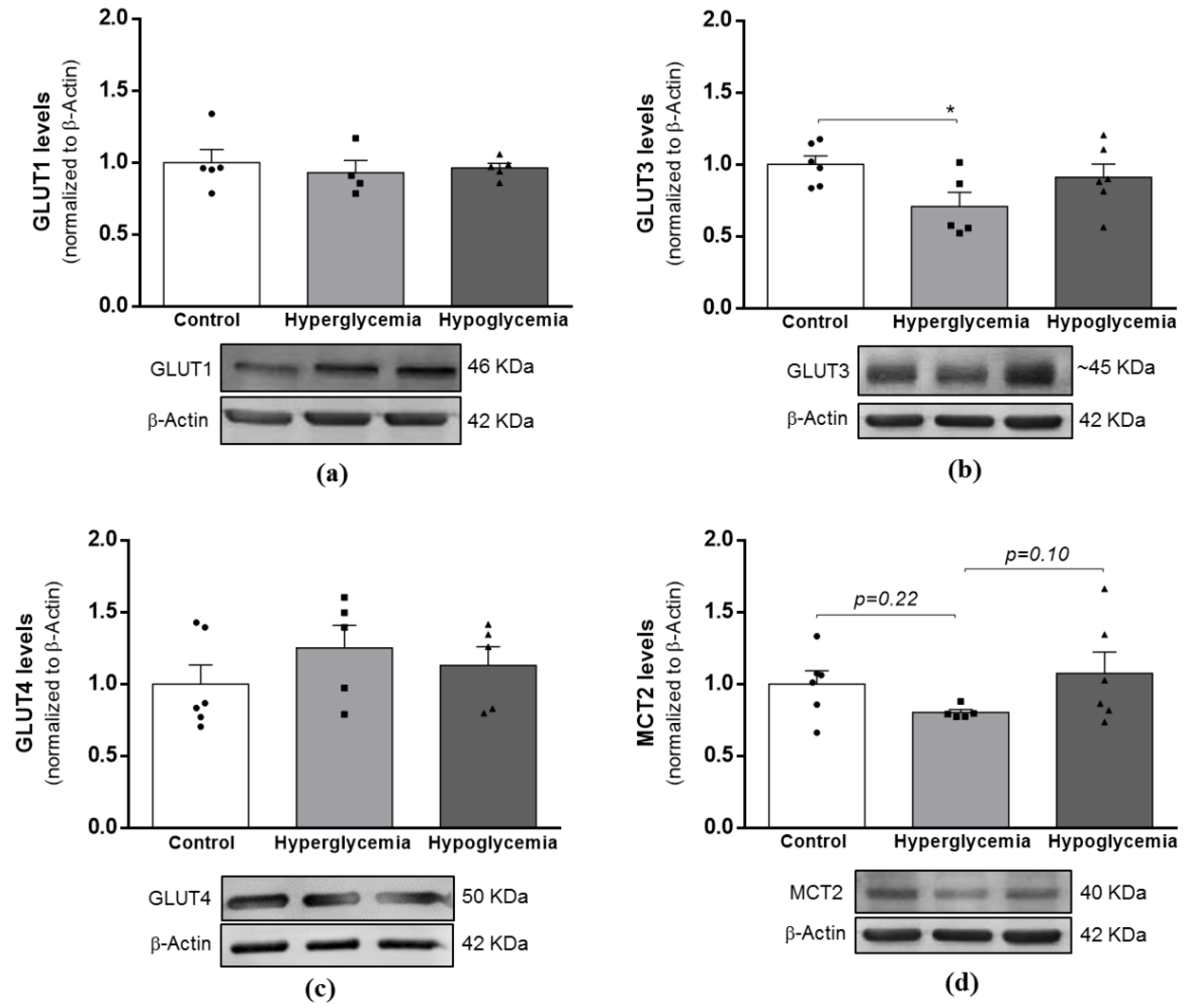

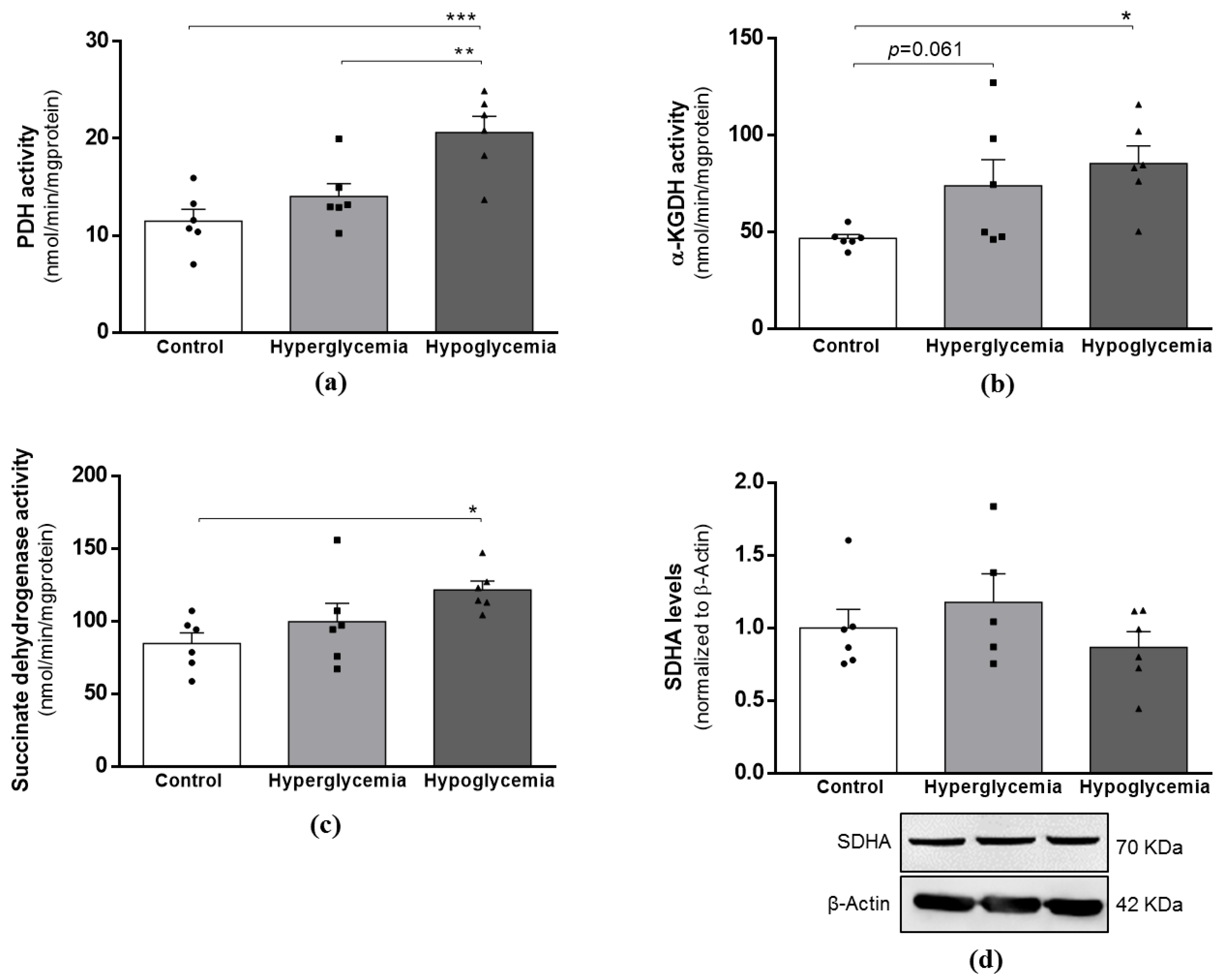
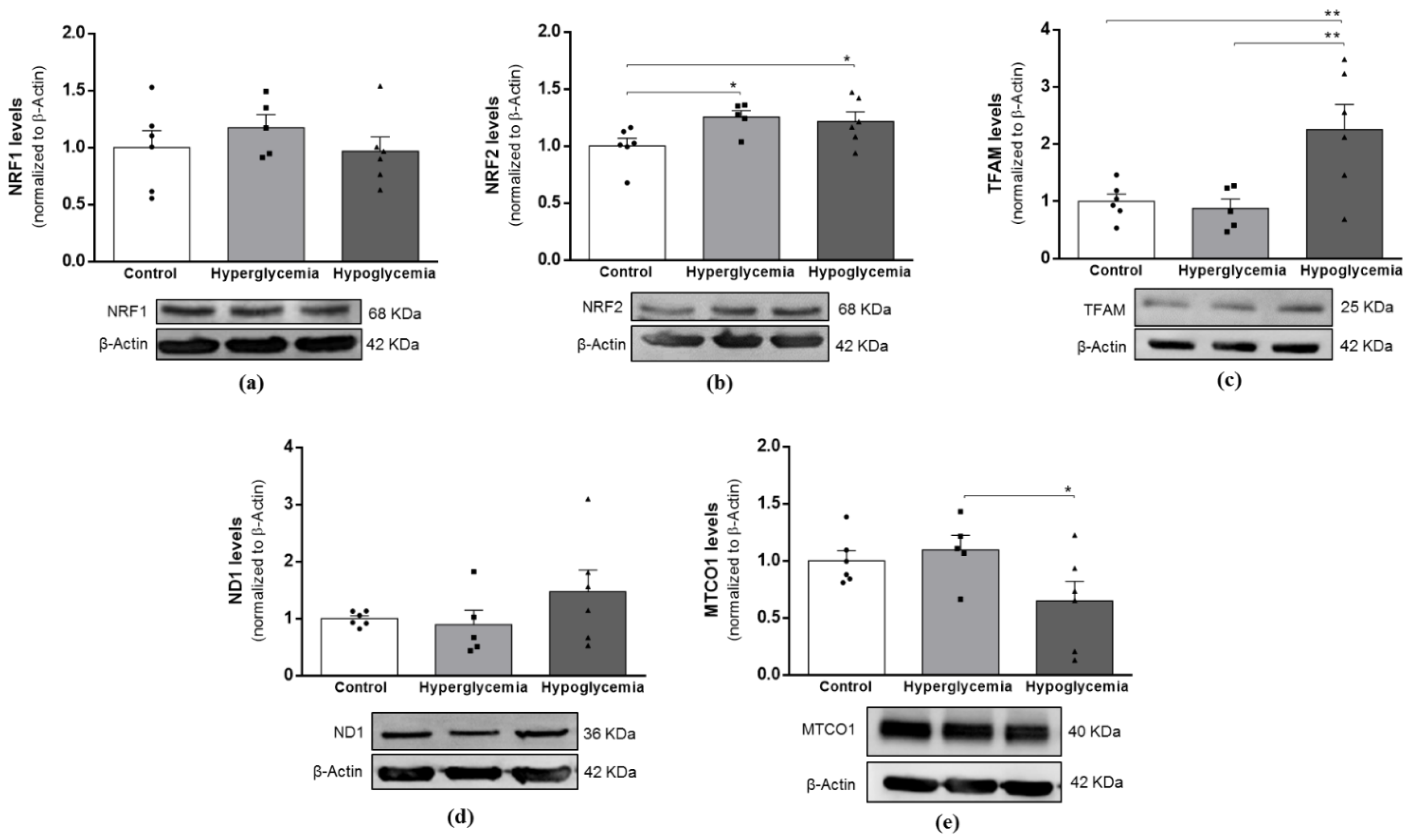
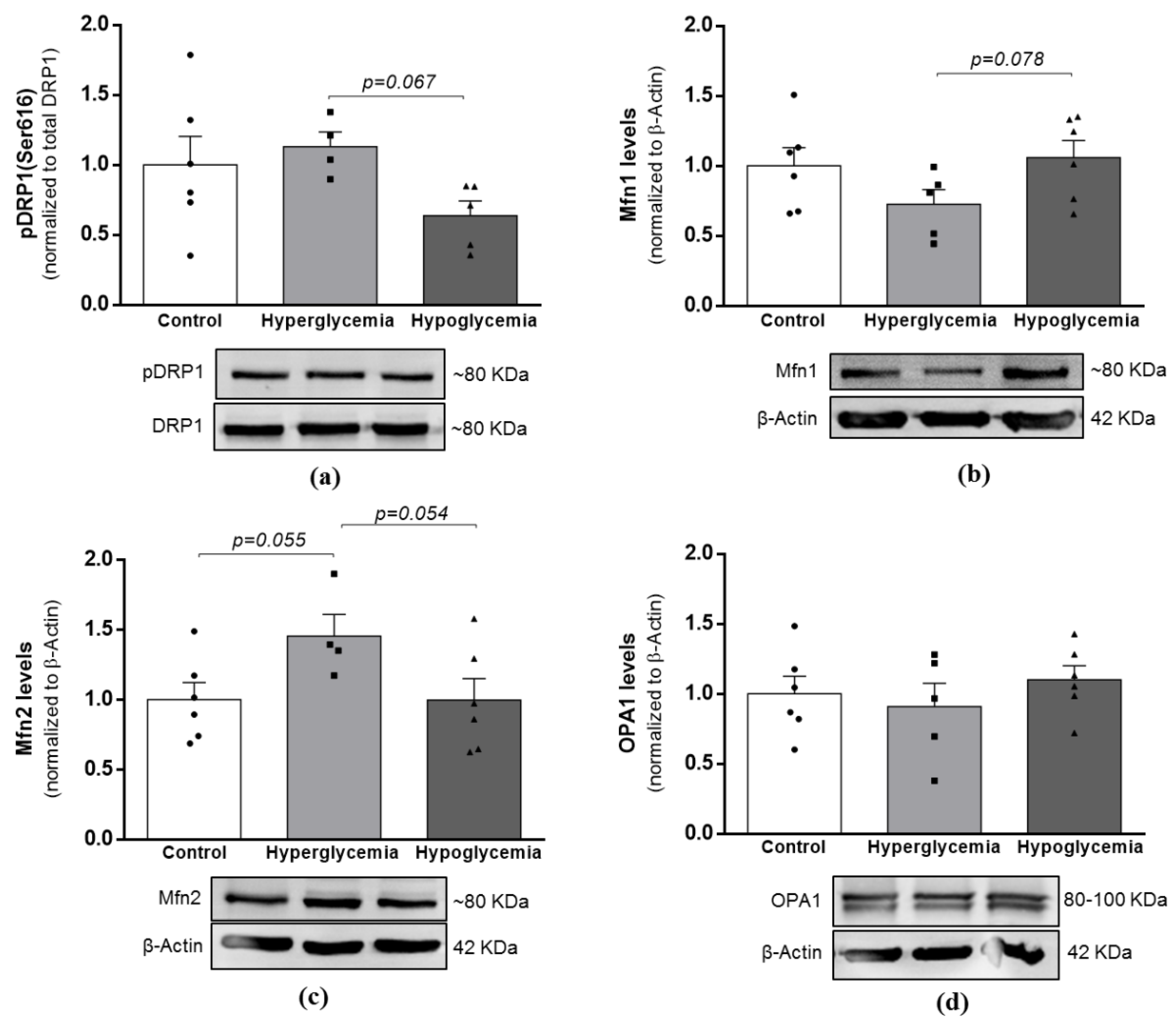

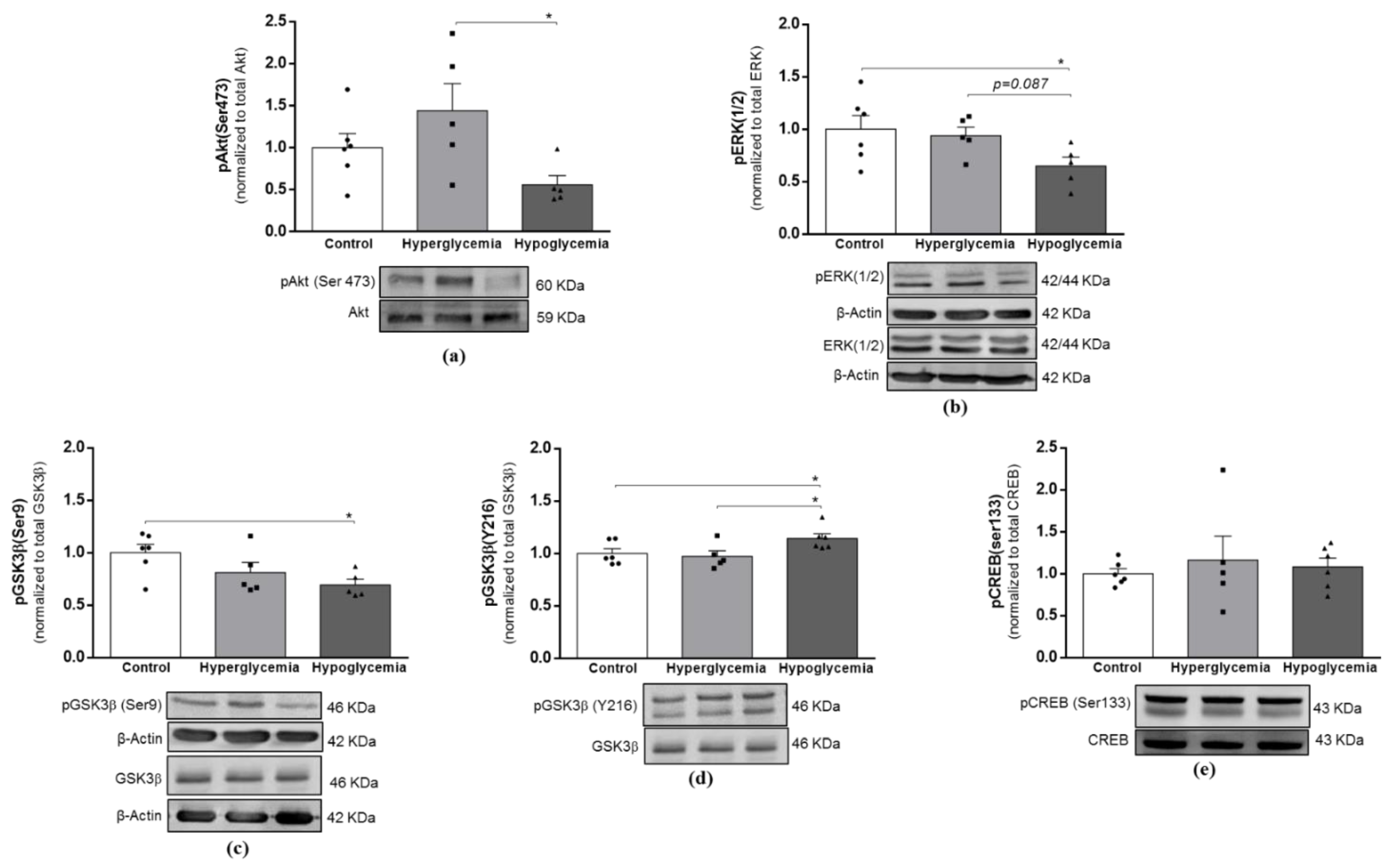
| Groups | Body Weight (g) | Brain Weight (g) | Glucose (mg/dl) | HbA1C (%) |
|---|---|---|---|---|
| Control | 442 ± 7.9 | 1.99 ± 0.03 | 122.3 ± 2.5 | 3.6 ± 0.03 |
| Hyperglycemia | 280 ± 6.5 **** | 1.96 ± 0.05 | 472.8 ± 28.6 **** | 8.5 ± 0.40 **** |
| Recurrent Hypoglycemia | 330 ± 17.7 ****; ++ | 2.10 ± 0.13 | 44.8 ± 6.8 **; ++++ | 7.1 ± 0.27 ****; ++ |
Publisher’s Note: MDPI stays neutral with regard to jurisdictional claims in published maps and institutional affiliations. |
© 2021 by the authors. Licensee MDPI, Basel, Switzerland. This article is an open access article distributed under the terms and conditions of the Creative Commons Attribution (CC BY) license (https://creativecommons.org/licenses/by/4.0/).
Share and Cite
Cardoso, S.; Moreira, P.I. Insulin-Induced Recurrent Hypoglycemia Up-Regulates Glucose Metabolism in the Brain Cortex of Chemically Induced Diabetic Rats. Int. J. Mol. Sci. 2021, 22, 13470. https://doi.org/10.3390/ijms222413470
Cardoso S, Moreira PI. Insulin-Induced Recurrent Hypoglycemia Up-Regulates Glucose Metabolism in the Brain Cortex of Chemically Induced Diabetic Rats. International Journal of Molecular Sciences. 2021; 22(24):13470. https://doi.org/10.3390/ijms222413470
Chicago/Turabian StyleCardoso, Susana, and Paula I. Moreira. 2021. "Insulin-Induced Recurrent Hypoglycemia Up-Regulates Glucose Metabolism in the Brain Cortex of Chemically Induced Diabetic Rats" International Journal of Molecular Sciences 22, no. 24: 13470. https://doi.org/10.3390/ijms222413470
APA StyleCardoso, S., & Moreira, P. I. (2021). Insulin-Induced Recurrent Hypoglycemia Up-Regulates Glucose Metabolism in the Brain Cortex of Chemically Induced Diabetic Rats. International Journal of Molecular Sciences, 22(24), 13470. https://doi.org/10.3390/ijms222413470







